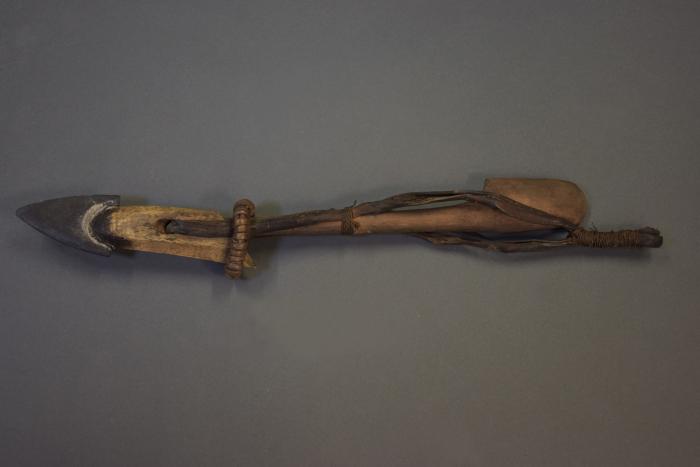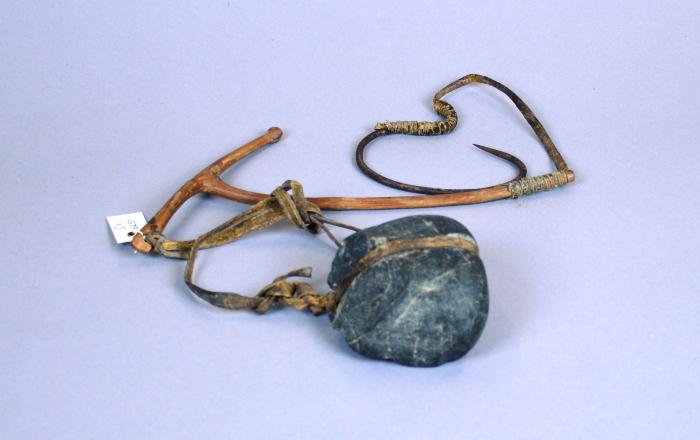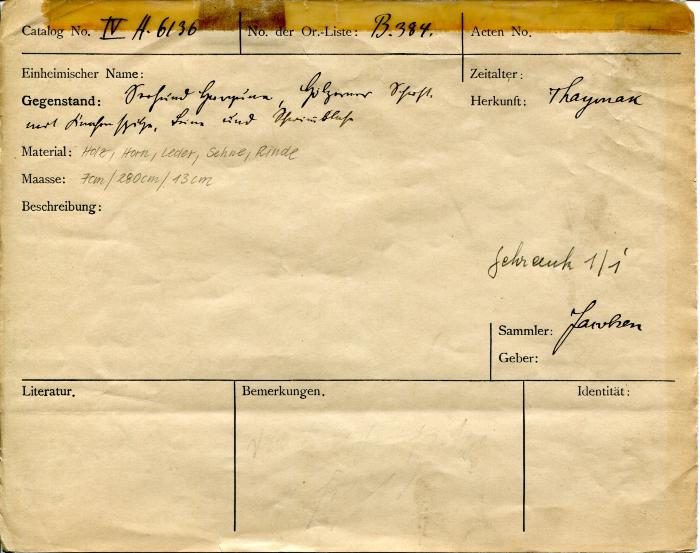Discussion of Halibut Hooks, Harpoons, and Marine Hunting Implements
Berlin Ethnological Museum (Contributor)
Chugach Alaska Corporation (Contributor)
Chugach Heritage Foundation (Contributor)
Chugachmiut (Contributor)
John F.C. Johnson (Contributor)
Dawn Randazzo (Contributor)
Brandon Moonin (Contributor)
Raymond Eric Clock (Contributor)
Deborah McMullen (Contributor)
William Smith (Contributor)
Chugach Alaska Corporation (Contributor)
Chugach Heritage Foundation (Contributor)
Chugachmiut (Contributor)
John F.C. Johnson (Contributor)
Dawn Randazzo (Contributor)
Brandon Moonin (Contributor)
Raymond Eric Clock (Contributor)
Deborah McMullen (Contributor)
William Smith (Contributor)
The Chugachmiut delegation to the Berlin Ethnological Museum engages in a group discussion about the hunting artifacts, their materials, uses, and connected stories and cultural knowledge.
John Johnson and Dawn Randazzo lead a group discussion initially focused on halibut hooks from the Copper River Delta. Randazzo invites participants to consider whether the hooks resemble any other artifacts from the region. Bill Smith reflects on the difficulty of answering due to cultural loss. Johnson remarks on intergroup influence, citing the evolution from dugouts to qayaqs. Smith shares that harpoons may have been used to drag sea otters—possibly multiple—behind boats. Johnson adds details about seal hunting practices, noting that animals were traditionally struck after surfacing for air to ensure buoyancy.
The conversation touches on Eyak settlements upland along the Copper River and their linguistic ties to the Ahtna. Participants examine a harpoon point from Chenega used for large marine mammals; Johnson references Frederica deLaguna’s observation that Chenega people had darker complexions due to high consumption of seal and sea lion. He also comments on the materials used in artifact construction, including glue-like pitch, sinew, rawhide, and copper, the latter suggesting trade.
Brandon Moonin observes that Jacobsen’s label for one of the harpoon points uses the Sugt’stun word for “present,” raising the possibility of Jacobsen misinterpreting the word for "present" to be the name for the tool. Johnson describes historical practices of chasing sea otters to exhaustion and clubbing them to preserve fur quality. He relays a story from an Elder at Nuchuek in which someone from the Kenaitze tribe accidentally drowned by tying a halibut hook string around their hand.
A sinker believed to be used in both warfare and subsistence is examined, with Johnson explaining its connection to the halibut hook and marveling at the durability of the materials. The group discusses the evolution from J-hooks to circle hooks and how modern technology mirrors Indigenous innovation. They also examine a seal harpoon and bladder float. Randazzo recalls inflating halibut stomachs at Nuuciq Spirit Camp, while Johnson notes bladders’ use as both floats and storage containers in smokehouses and during celebratory New Year’s events in Kodiak during the performative fights.
Discussion also includes hunting techniques involving platforms built in trees for beluga hunting. Smith wonders if the length of a particular harpoon implies use from a stationary platform rather than a qayaq. Moonin identifies a notch at the base of the harpoon that would fit into an atlatl, which Johnson explains increased the speed and force of a thrown weapon. Raymond Eric Clock and Moonin comment on how the harpoon’s ability to come apart aids transportation; Randazzo adds this could also simplify repairs.
The conversation touches on Eyak settlements upland along the Copper River and their linguistic ties to the Ahtna. Participants examine a harpoon point from Chenega used for large marine mammals; Johnson references Frederica deLaguna’s observation that Chenega people had darker complexions due to high consumption of seal and sea lion. He also comments on the materials used in artifact construction, including glue-like pitch, sinew, rawhide, and copper, the latter suggesting trade.
Brandon Moonin observes that Jacobsen’s label for one of the harpoon points uses the Sugt’stun word for “present,” raising the possibility of Jacobsen misinterpreting the word for "present" to be the name for the tool. Johnson describes historical practices of chasing sea otters to exhaustion and clubbing them to preserve fur quality. He relays a story from an Elder at Nuchuek in which someone from the Kenaitze tribe accidentally drowned by tying a halibut hook string around their hand.
A sinker believed to be used in both warfare and subsistence is examined, with Johnson explaining its connection to the halibut hook and marveling at the durability of the materials. The group discusses the evolution from J-hooks to circle hooks and how modern technology mirrors Indigenous innovation. They also examine a seal harpoon and bladder float. Randazzo recalls inflating halibut stomachs at Nuuciq Spirit Camp, while Johnson notes bladders’ use as both floats and storage containers in smokehouses and during celebratory New Year’s events in Kodiak during the performative fights.
Discussion also includes hunting techniques involving platforms built in trees for beluga hunting. Smith wonders if the length of a particular harpoon implies use from a stationary platform rather than a qayaq. Moonin identifies a notch at the base of the harpoon that would fit into an atlatl, which Johnson explains increased the speed and force of a thrown weapon. Raymond Eric Clock and Moonin comment on how the harpoon’s ability to come apart aids transportation; Randazzo adds this could also simplify repairs.
Do you have a story to contribute or a comment about this item?
Login/register to comment April 28 2023
Born Digital
2023.010.284.MP4
Copyright 2023 Chugachmiut Heritage Preservation





